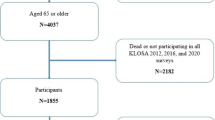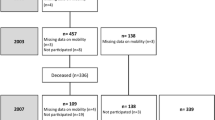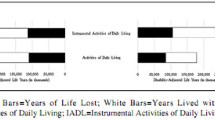Abstract
Background and aims: Some studies have reported a decline in disability prevalence in older people, but few data were available for Europe, especially for France. Our aim was to study the 10-year evolution of disability prevalence in elderly community dwellers and related factors. Methods: Two generations of subjects aged 75 to 84, participants in the PAQUID (Personnes Agées QUID) cohort were compared. The first generation included 1496 subjects (born between 1903 and 1912) and the second 910 subjects (born between 1913 and 1922). Three domains of disability were assessed: mobility, Activities of Daily Living (ADL) and Instrumental ADL (IADL). Logistic regressions were used to explain the effect of generation on disability, controlling for sociodemographic characteristics, impairment, life-style, medical care, and social support. Results: The percentage of subjects fully independent increased from 13.5 to 23.3% (p<0.001). A large decline in disability prevalence independent of the controlled factors was observed for mobility in both genders [Odds Ratio for the second generation (ORG2)=0.48, 95% CI 0.38–0.60]. When adjusting for age and education, the risk of IADL disability was significantly lower in women in the second generation (ORG2 0.61, 95% CI 0.49–0.77), and the generation effect was strengthened when adjusting for the other covariates, but unchanged in men (ORG2 1.09, 95% CI 0.81–1.48). There was no significant change for ADL. Conclusions: A significant decline in disability prevalence was observed over 10 years, which was not explained by the selected covariates. These aggregate changes differed by gender, education, and the domain of disability considered.
Similar content being viewed by others
References
Singer BH, Manton KG. The effects of health changes on projections of health service needs for the elderly population of the United States. Proc Natl Acad Sci USA 1998; 95: 15618–22.
Colvez A, Blanchet M. Disability trends in the United States population 1966–76: analysis of reported causes. Am J Public Health 1981; 71: 464–71.
Manton KG, Corder L, Stallard E. Chronic disability trends in elderly United States populations: 1982–1994. Proc Natl Acad Sci USA 1997; 94: 2593–8.
Manton KG, Gu X. Changes in the prevalence of chronic disability in the United States black and nonblack population above age 65 from 1982 to 1999. Proc Natl Acad Sci USA 2001; 98: 6354–9.
Schoeni RF, Freedman VA, Wallace RB. Persistent, consistent, widespread, and robust? Another look at recent trends in old-age disability. J Gerontol 2001; 56: S206–18.
Freedman VA, Martin LG, Schoeni RF. Recent trends in disability and functioning among older adults in the United States: a systematic review. JAMA 2002; 288: 3137–46.
Barberger-Gateau P, Chaslerie A, Dartigues JF, Commenges D, Gagnon M, Salamon R. Health measures correlates in a French elderly community population: the PAQUID study. J Gerontol 1992; 47: S88–95.
Dartigues JF, Gagnon M, Michel P, et al. The Paquid research program on the epidemiology of dementia. Methods and initial results. Rev Neurol (Paris) 1991; 147: 225–30 (in French).
Katz S, Downs TD, Cash HR, Grotz RC. Progress in development of the index of ADL. Gerontologist 1970; 10: 20–30.
Spector WD. Functional disability scales. In Spilker B, ed. Quality of life assessments in clinical trials. New York: Raven Press, 1990: 115–29.
Lawton MP, Brody EM. Assessment of older people: self-maintaining and instrumental activities of daily living. Gerontologist 1969; 9: 179–86.
Rosow I, Breslau N. A Guttman health scale for the aged. J Gerontol 1966; 21: 556–9.
Pérès K, Barberger-Gateau P. Evolution of disability between 75 and 84 years: follow-up of two generations of the PAQUID survey. Gérontologie et Société 2001; 98: 49–64 (in French).
Folstein M, Folstein SE, McHugh PR. “Mini-mental state”. A practical method for grading the cognitive state of patients for the clinician. J Psychiatr Res 1975; 12: 189–98.
Jacqmin-Gadda H, Fabrigoule C, Commenges D, Dartigues JF. A 5-year longitudinal study of the Mini-Mental State Examination in normal aging. Am J Epidemiol 1997; 145: 498–506.
Radloff S. The CES-D scale: a self-report depression scale for research in the general population. Appl Psychol Meas 1977; 1: 385–401.
Lemeshow S, Letenneur L, Dartigues JF, Lafont S, Orgogozo JM, Commenges D. Illustration of analysis taking into account complex survey considerations: the association between wine consumption and dementia in the PAQUID study. Personnes Agées QUID. Am J Epidemiol 1998; 148: 298–306.
Pitkala KH, Valvanne J, Kulp S, Strandberg TE, Tilvis RS. Secular trends in self-reported functioning, need for assistance and attitudes towards life: 10-year differences of three older cohorts. J Am Geriatr Soc 2001; 49: 596–600.
Liao Y, McGee DL, Cao G, Cooper RS. Recent changes in the health status of the older U.S. population: findings from the 1984 and 1994 supplement on aging. J Am Geriatr Soc 2001; 49: 443–9.
Waidmann TA, Liu K. Disability trends among elderly persons and implications for the future. J Gerontol 2000; 55: S298–307.
Crimmins EM, Saito Y, Reynolds SL. Further evidence on recent trends in the prevalence and incidence of disability among older Americans from two sources: the LSOA and the NHIS. J Gerontol 1997; 52: S59–71.
Freedman VA, Martin LG. Understanding trends in functional limitations among older Americans. Am J Public Health 1998; 88: 1457–62.
Leveille SG, Resnick HE, Balfour J. Gender differences in disability: evidence and underlying reasons. Aging Clin Exp Res 2000; 12: 106–12.
Barberger-Gateau P, Rainville C, Letenneur L, Dartigues JF. A hierarchical model of domains of disablement in the elderly: a longitudinal approach. Disabil Rehabil 2000; 22: 308–17.
Barberger-Gateau P, Fabrigoule C, Helmer C, Rouch I, Dartigues JF. Functional impairment in instrumental activities of daily living: an early clinical sign of dementia? J Am Geriatr Soc 1999; 47: 456–62.
Freedman VA, Aykan H, Martin LG. Aggregate changes in severe cognitive impairment among older Americans: 1993 and 1998. J Gerontol 2001; 56: S100–11.
Cutler DM. The reduction in disability among the elderly. Proc Natl Acad Sci USA 2001; 98: 6546–7.
Allaire SH, LaValley MP, Evans SR, et al. Evidence for decline in disability and improved health among persons aged 55 to 70 years: the Framingham Heart Study. Am J Public Health 1999; 89: 1678–83.
Jagger C, Clarke M, Clarke SJ. Getting older — feeling younger: the changing health profile of the elderly. Int J Epidemiol 1991; 20: 234–8.
Author information
Authors and Affiliations
Corresponding author
Additional information
Part of this paper was presented at the REVES 2002 meeting — Hammamet, Tunisia, April 24–26, 2002.
Rights and permissions
About this article
Cite this article
Pérès, K., Helmer, C., Letenneur, L. et al. Ten-year change in disability prevalence and related factors in two generations of French elderly community dwellers: data from the PAQUID study. Aging Clin Exp Res 17, 229–235 (2005). https://doi.org/10.1007/BF03324602
Received:
Accepted:
Published:
Issue Date:
DOI: https://doi.org/10.1007/BF03324602




